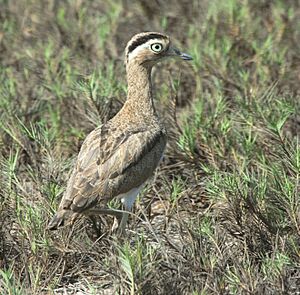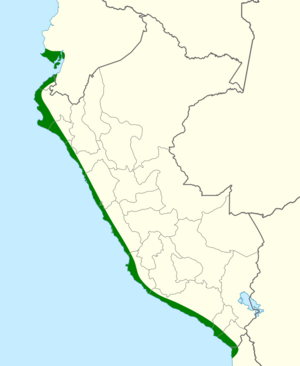Peruvian thick-knee facts for kids
Quick facts for kids Peruvian thick-knee |
|
|---|---|
 |
|
| at Santa Cruz de Flores, Lima, Peru | |
| Conservation status | |
| Scientific classification | |
| Genus: |
Hesperoburhinus
|
| Species: |
superciliaris
|
 |
|
| range (year-round resident) | |
The Peruvian thick-knee (Hesperoburhinus superciliaris) is a special type of bird. It belongs to a family of birds called Burhinidae. You can find this bird in Chile, Ecuador, and Peru. It likes to live in dry, warm areas with shrubland or grassland. It also lives in farm fields. This bird spends most of its time on the ground. It eats insects and other small creatures.
Contents
What is a Peruvian Thick-knee?
Meet the Peruvian Thick-knee Bird
The Peruvian thick-knee was first officially described in 1843. A Swiss scientist named Johann Jakob von Tschudi gave it its scientific name. He found a specimen, which is a sample, in Peru. The name superciliaris means "eyebrowed" in Latin. This is because of the white stripe above its eye.
For a long time, this bird was part of the Burhinus group. But recently, in 2024, scientists moved it to a new group called Hesperoburhinus. This bird is unique because there are no different types or subspecies of it. It's just one kind of Peruvian thick-knee.
What Does the Peruvian Thick-knee Look Like?
Physical Features of the Peruvian Thick-knee
This bird is a medium-sized bird. It has brownish-grey feathers with brown stripes and spots. This helps it blend in with its surroundings. Its belly is white, and its legs are long and yellow. It has a clear white stripe that goes through its eye. Above this white stripe is a black line. Its beak is short and has a black tip. The Peruvian thick-knee is about 40 centimeters (about 16 inches) long.
Where Does the Peruvian Thick-knee Live?
Peruvian Thick-knee Habitat and Range
The Peruvian thick-knee lives in South America. It stays in the narrow strip of land between the Pacific Ocean and the Andes Mountains. Its home stretches from northern Chile, through Peru, and up to southern Ecuador.
It prefers places that are like semi-deserts. It also likes farmland, dry fields, or green river valleys. It especially enjoys open fields where crops like alfalfa or corn are grown.
How Does the Peruvian Thick-knee Behave?
Daily Life and Diet of the Peruvian Thick-knee
The Peruvian thick-knee is mostly active at night. During the day, it rests. It walks around on the ground looking for food. It probably eats insects, small lizards, and other tiny animals. When it runs, it looks a bit like an ostrich.
During the day, it stays very still in open areas. Its brownish feathers help it hide very well. It's hard to spot! You might find it by looking for its special three-toed footprints in soft sand. At night, you can hear its calls. They sound a bit like a lapwing bird.
Peruvian Thick-knee Reproduction and Life Cycle
Scientists don't know much about how these birds have babies. However, one nest was found in June in Peru. It had two eggs. The nest was a simple scrape on the ground. The area around it was cleared of small rocks and plants. The eggs were cream-colored with tan and dark brown spots. They were about 53 by 39 millimeters (about 2.1 by 1.5 inches). One parent was sitting on the eggs to keep them warm. The other parent stood nearby in the shade.
Is the Peruvian Thick-knee in Danger?
Conservation Status of the Peruvian Thick-knee
The IUCN (International Union for Conservation of Nature) keeps track of how many animals are left in the world. They have listed the Peruvian thick-knee as "least concern". This means it's not currently in danger of disappearing.
Even though it lives in a somewhat small area, the bird is quite common. Especially in the northern parts of its home range. We don't know if its numbers are going up or down. But for now, it seems to be doing well.


